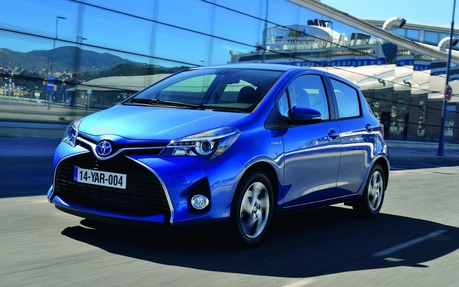Toyota Yaris: A new Nationality for 2015!
The third generation Toyota Yaris has been with us since 2011 and, in such a competitive segment, not renewing a model fast enough is tantamount to suicide. Three years and one discontinuation later – the Yaris sedan was eliminated from the lineup, leaving only the three- and five-door versions – the time has come for a mid-cycle makeover to help the vehicle keep pace with its rivals. The remodelled 2015 Yaris will arrive at a dealership near you in the next few months.
Not only is the 2015 Yaris getting a makeover, but it’s getting a brand new nationality too. Formerly made in Japan, it will now be designed, engineered and produced in France. This is a major change for Toyota, which has decided to put the future of its compact and sub-compact models in the hands of its European branch. The reason is simple: the European market is crazy for this type of vehicle, and Toyota wants to ensure that these models meet buyers’ needs to the letter. The same philosophy prompted Toyota to move the entirety of its Camry and Tundra production to North America – it wants specialized hubs of activity in every region of the world.
Like many sub-compacts, the Yaris is a very important model in Canada, and especially in Quebec, which accounts for more than 60% of Canadian sales. In the U.S., the Camry is the big seller. Since we have a certain weakness for European models, the arrival of this French model is very good news.
Mainly esthetic changes
Despite the new passport, the 2015 edition keeps many of the current version’s components. In fact, the changes are primarily cosmetic. The 2015 Yaris’ front end is definitely this makeover’s most noticeable feature and this time, no one can accuse Toyota of not being daring. In large part, it owes its much more assertive style to a large trapezoidal bottom grille that seems to lower the front of the vehicle, making it a little more serious and a lot more dynamic. It rises to meet the much smaller upper grille and frames the Toyota logo in the centre. The daytime running lights are now made up of a strip of LED lamps on certain versions. Although the changes to the sides are much more subtle, the rear bumper has been completely redesigned to reinforce the car’s wider and lower stance. The very nice new LED lights become the model’s visual signature in the back. Basically, the designers wanted it to stand out from the pack and distance it from the dull image all too often associated with Toyota products. They finally understand that style is as big a selling point as reliability.
In the passenger compartment, the novelty lies mainly in a redesigned dashboard and its less high and more horizontal style, not unlike that of the Scion tC. The smooth materials in the doors and on the dash add to an overall impression of quality. The central feature, a 6.1-inch screen, enhances the presentation of the multimedia system’s information. Toyota toyed with the decor to make it more modern and reduced the height of the shifter to improve ergonomics.
No mechanical changes
There are no major mechanical changes to report, and all versions of the Yaris (CE, LE, SE) have the same engine, namely a 1.5-litre four-cylinder that produces 106 horsepower at 6,000 rpm and a torque rating of 103 lb.-ft. Most of its rivals have similar output, but it trails the Hyundai Accent/Kia Rio duo and their 138 horses. As for the transmission, the five-speed manual is still appropriate for the base version and they also brought back the four-speed automatic. That happens to be our primary disappointment with this makeover: we were hoping for at least a five-speed automatic (the competition is even offering six-speed automatics), but it seems that Toyota decided to hold off until the model is completely revamped. Okay, maybe manual transmissions are more popular in Europe and the number of speeds on an automatic gearbox is less important over there, but on this side of the pond, that’s not how it is. The Yaris is lagging behind the competition in this regard.
A few modifications to the chassis and suspension optimize handling. The engineers slightly upgraded the structural rigidity with the use of bonding agents instead of welds and they also redesigned the rear suspension by incorporating a new, more rigid torsion bar. The electromechanical steering offers more feedback than it did in the past. The goal of all these changes was to increase the driver’s feeling of control and safety while maintaining the comfort level.
The pricing for the 2015 Yaris will be revealed later, but the giant Japanese automaker will undoubtedly have to adjust for increasingly ferocious competition – especially from the Korean manufacturers offering impressive equipment levels for the price and from Nissan, whose Micra priced at less than $10,000 is the talk of the segment.
